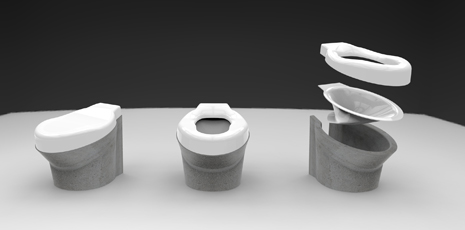
LuLoo – an aspirational toilet for all designed by a team at Loughborough University’s Design School
In the developing world 2.5 billion people lack basic sanitation.
This is a huge problem and in October 2013, the Department of Biotechnology (DBT) under the Ministry of Science and Technology of the Government of India and the Bill & Melinda Gates Foundation in collaboration with India’s Biotechnology Industry Research Assistance Council (BIRAC) launched the Reinvent the Toilet Challenge:India.
One of the multidisciplinary teams that received funding to develop their ideas was formed by Loughborough University’s Water, Engineering and Development Centre (WEDC) and consisted of research associates at the University’s Design School.
The Design School’s specific role in the team was to explore the design and manufacture of the toilet itself creating a solution that is desirable, functional, eco-friendly and easy to manufacture.
The aim was to move away from traditional ceramic toilets, which are expensive and complicated to manufacture. By breaking the toilet down into three simple components, the designers managed to create a solution that could support local businesses and skills.
The toilet base, for instance, could be constructed by local stone masons or pot manufacturers in concrete. With just the one mould, they can produce varying heights of toilet bases, varying appearances of toilets and even a urinal.

Toilet base mould, varying heights and urinal
“Rethinking how to take the existing skills and materials used by local crafts people and adopting these to create a new product, that is still low cost but doesn’t sacrifice on aspirational value was very rewarding,” describes Paul Mackereth, a research associate at the Design School.
The aspirational aspect was paramount because although the toilet had to be durable, cost-effective and repairable, it also needed to be aesthetically pleasing so that users would take pride in it.
As Mackereth says, “After conducting user research with international post grad students, then with Indian city slum residents and people from neighbouring villages, it became very obvious that all people have desires for aspirational and attractive products.
“Just because some people lack the financial means to buy the latest and greatest doesn’t mean that there can’t be a low cost way of delivering the same user experience for them in new and creative ways.”
Although the base is made of concrete, the design team explored various dyes, polishes and paints so that the toilets could be decorated and customised.

Span of toilet appearance using finishes, paints and polish
The designers created various role play prototypes and following a field trip to India, realised that different heights were preferred from a sitting position to a semi-squat and squat.
Changes were also made to the seat to accommodate a range of user needs from those who wash with water to those who wipe with paper. The contact surface area on the seat was also increased to provide comfort and minimise pressure points in the different sitting positions.
“The opportunity to be involved in re-inventing the design of the toilet was a challenging but rewarding experience for us as a team. It is important that designers get involved in complex social design projects like this,” says fellow Design School team member, Diane Gyi.

The various seating positions from squat, semi-squat and sit
The toilet prototypes were exhibited at the Reinvent the Toilet Fair held in New Delhi during March 2014. The Fair was co-hosted by the Government of India’s Department of Biotechnology and the Bill & Melinda Gates Foundation, with the support of India’s Ministry of Urban Development.
The Design School are currently looking towards possible field testing and further development with partners around the world. For more information email {encode=”P.Mackereth@lboro.ac.uk” title=”Paul Mackereth”}.






